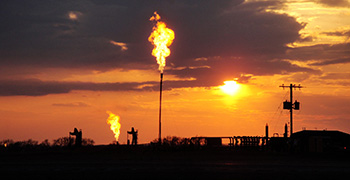A .gov website belongs to an official government organization in the United States.
A lock () or https:// means you've safely connected to the .gov website. Share sensitive information only on official, secure websites.
8 September 2015

A new NOAA-led study measures "soot" from North Dakota flares.
In the lonely reaches of northwestern North Dakota and across the border into Saskatchewan, the vast Bakken oil field hosts extensive activities to extract both crude oil and natural gas. Business is booming – production increased by 30 percent between May 2013 and May 2014. More than a quarter of the total gas produced from the Bakken operations can't be processed fast enough, though, and the common industry practice is to "flare" it – burn it off as it is vented to the atmosphere. Jutting 30 feet upward like enormous lit matchsticks, the flares pose a new question for atmospheric scientists: What do the flares put into the air? A new NOAA-led study has produced the first direct measurements of how much black carbon – a major component of airborne particles that are commonly referred to as "soot" – is emitted by the Bakken flaring operations.
The answer? "The flaring releases about 4 tons of black carbon a day, which hasn't been previously accounted for," said Joshua Schwarz, a research scientist at NOAA and lead author of the study, published online September 8 in Environmental Science & Technology Letters. "Fortunately, this amount is not significant for global climate because it is less than 1 percent of all the black carbon emitted in North America."
Researchers from NOAA, the Cooperative Institute for Research in Environmental Sciences (CIRES) at the University of Colorado Boulder and the University of Michigan measured the emissions of black carbon during six flights of the NOAA Twin Otter research aircraft in May 2014. On board was the NOAA Single Particle Soot Photometer (SP2), an instrument that measures black carbon atmospheric concentration and microphysical properties. Black carbon is a product of incomplete combustion of fossil fuels and biomass, and its absorption properties make it a warming influence on climate. It is also harmful to human health when inhaled.

In the six flights, the research aircraft traversed the Bakken region during periods of steady high winds, sampling to get a "background" reading of the black carbon levels and then across the Bakken to measure the increases in black carbon resulting from the flaring operations. Researchers were able to use their data to calculate the black carbon emission rate for the region and estimate the amounts coming from the oil and gas production operations, primarily flaring.
The bottom line from the new study? Assuming the May 2014 measurement period was representative of yearly operations, the researchers find that an upper limit of 1400 ± 360 tons of black carbon are emitted each year from the flares at the Bakken region. Total emissions of black carbon in North America were estimated to be 380,000 tons per year in 2000.
The new study's findings are likely indicative of North America, because about 40 percent of the total flaring that occurs in the U.S. is in the Bakken region. However, the authors note that on the global scale, North America makes up less than 10 percent of the total flaring, and they caution that the results may be different in other regions of the world.
Authors of "Black Carbon Emissions from the Bakken Oil and Gas Development Region" in Environmental Science & Technology Letters include NOAA's Joshua P. Schwarz and Thomas B. Ryerson; John S. Holloway, Joseph M. Katich, Stuart McKeen, Colm Sweeney, and Jeff Peischl from CIRES and NOAA; and Eric A. Kort and Mackenzie L. Smith from the University of Michigan.
Joshua P. Schwarz, John S. Holloway, Joseph M. Katich, Stuart McKeen, Eric A. Kort, Mackenzie L. Smith, Thomas B. Ryerson, Colm Sweeney, and Jeff Peischl, Black Carbon Emissions from the Bakken Oil and Gas Development Region, Environmental Science & Technology Letters, doi:10.1021/acs.estlett.5b00225, 2015.
Black carbon (BC) emission rates from the Bakken oil-producing region of North Dakota have been quantified with a NOAA airborne single-particle soot photometer (SP2). Flights in May 2014 led to six measurements of the BC emission rate in the region. Oil and gas operations (associated flaring, diesel engines associated with pumping and drilling, and oil production-related transport), limited agricultural burning, and sparse urban/transport sector activity contribute to these emissions. The BC emission rate was 1400 ± 360 t year−1, implying that Bakken production activities are unlikely to contribute to large-scale biases in estimates of BC emissions. An upper limit on the BC emission factor from flaring based on these observations is 0.57 ± 0.14 g/m−3. Flaring BC was not associated with optically significant internally mixed non-BC material or with significant emissions of non-BC-containing primary aerosol. BC in the outflow from the region was also generally externally mixed.